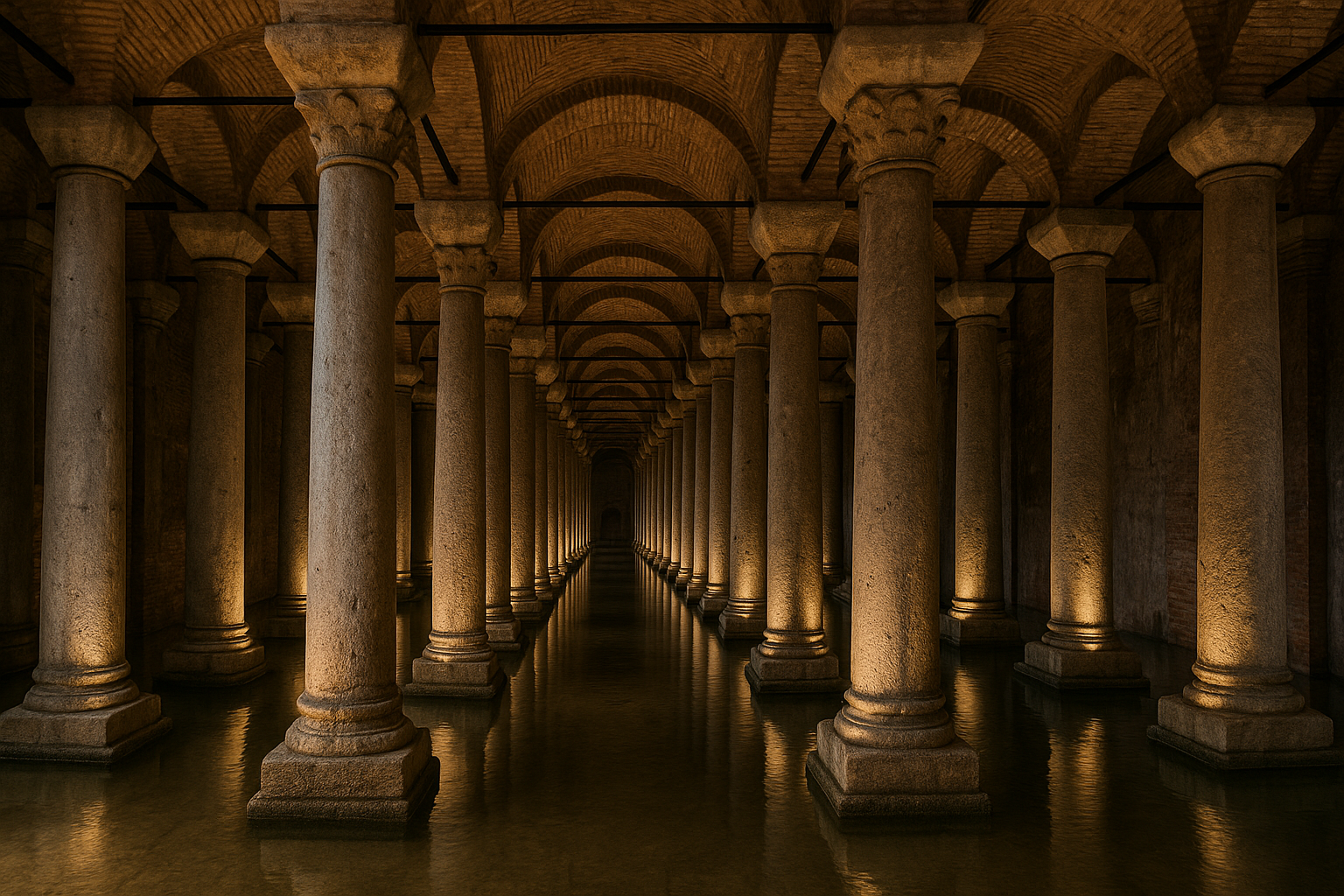
Binbirdirek Sarnıcı (Binbirdirek Cistern)
HISTORICAL BACKGROUND AND SIGNIFICANCE
The Binbirdirek Sarnıcı, or the Cistern of the Thousand and One Columns, is one of the lesser-known yet fascinating remnants of Byzantine engineering in Istanbul. Constructed during the reign of Emperor Justinian I in the 6th century, this underground water reservoir was built to supply water to the Great Palace of Constantinople. Its name, which translates to 'Cistern of the Thousand Columns,' is somewhat misleading; while it boasts 224 columns, the term reflects the grandeur and scale of the structure rather than the exact number of its supporting pillars.
The cistern was part of a vast network of water supply systems that included aqueducts and other cisterns, crucial for the survival of the city, especially during sieges. The Binbirdirek Sarnıcı was rediscovered in the 19th century, and since then, it has been a subject of interest for historians and archaeologists alike, shedding light on the advanced engineering skills of the Byzantine Empire.
ARCHITECTURAL FEATURES AND DESIGN ELEMENTS
The Binbirdirek Sarnıcı is an impressive example of Byzantine architecture, showcasing the ingenuity of ancient engineers. The cistern is approximately 140 meters long and 70 meters wide, with a ceiling height of about 9 meters. Its most striking feature is the 224 columns that support the roof, arranged in 8 rows of 28 columns each. These columns are made of various materials, including marble and granite, and many are repurposed from older Roman structures, reflecting the practice of reusing materials in Byzantine construction.
The columns are adorned with intricate capitals, some of which exhibit Corinthian designs, while others display more simplistic styles. The cistern's floor is covered with a layer of clay, which helped to waterproof the structure and prevent leakage. The overall design of the Binbirdirek Sarnıcı emphasizes both functionality and aesthetics, creating a serene and atmospheric environment that has captivated visitors for centuries.
CULTURAL AND RELIGIOUS IMPORTANCE
While primarily a water reservoir, the Binbirdirek Sarnıcı also holds cultural significance. In the Byzantine era, water was considered a symbol of purity and life, and cisterns played a vital role in the daily lives of the citizens. The availability of fresh water was crucial for both practical and ceremonial purposes, including religious rituals.
In modern times, the cistern has become a site of cultural heritage, reflecting the rich history of Istanbul as a crossroads of civilizations. It is often included in tours of Byzantine architecture and is a testament to the city's layered history, showcasing how ancient structures have been preserved and repurposed through the ages.
VISITOR EXPERIENCE AND WHAT TO EXPECT
Visiting the Binbirdirek Sarnıcı offers a unique glimpse into the underground world of Byzantine Istanbul. As you descend into the cistern, you are greeted by a cool, dimly lit atmosphere that contrasts sharply with the bustling city above. The sound of dripping water echoes through the space, adding to the mystical ambiance.
Inside, visitors can stroll along pathways that wind between the columns, allowing for a close-up view of the architectural details. The cistern is often adorned with artistic installations and lighting that enhance the experience, creating a magical atmosphere that feels like stepping back in time. Guided tours are available, providing insights into the history and significance of the structure, making the visit both educational and enjoyable.
INTERESTING FACTS AND ANECDOTES
1. The Binbirdirek Sarnıcı is said to have inspired various works of literature and art, including references in the writings of the famous Turkish author Orhan Pamuk. 2. The cistern is often compared to the more famous Basilica Cistern, but it is less crowded, offering a more intimate experience for visitors. 3. Legend has it that the name 'Binbirdirek' originated from the local belief that the columns were once part of a grand palace, and the number of columns was exaggerated over time. 4. The cistern has been used in various films and documentaries, showcasing its atmospheric and historical significance.
PRACTICAL VISITING INFORMATION
- **Hours**: The Binbirdirek Sarnıcı is typically open to visitors from 9 AM to 5 PM, but it is advisable to check the official website for any changes in hours or special events. - **Best Times to Visit**: Early morning or late afternoon are ideal times to visit, as the light filtering through the entrance enhances the atmosphere, and the crowds are generally smaller. - **Tips**: Wear comfortable shoes, as the pathways can be uneven. Photography is allowed, but be respectful of other visitors and the space. Consider joining a guided tour to gain deeper insights into the history and architecture of the cistern.
The Binbirdirek Sarnıcı is a hidden gem in Istanbul's rich tapestry of history, offering visitors a chance to explore the depths of Byzantine engineering and culture. Whether you are a history enthusiast, an architecture lover, or simply seeking a unique experience, this ancient cistern is sure to leave a lasting impression.